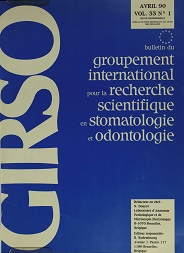Etude télécrânienne des mouvements cervicaux et palatins au cours de la croissance
Mots-clés :
La position sagittale de l’os hyoïde est à l’origine des modifications d’orientation des lames palatines. Ceci a été montré à partir de télécrânes sagittaux. Un mouvement postéro-antérieur de cet os permet à la langue de libérer la partie postérieure de lRésumé
La position sagittale de l’os hyoïde est à l’origine des modifications d’orientation des lames palatines. Ceci a été montré à partir de télécrânes sagittaux. Un mouvement postéro-antérieur de cet os permet à la langue de libérer la partie postérieure de la cavité buccale: les lames palatines font une rotation vers le bas et l’avant. Le contraire se vérifie de la même façon. Le canal naso-palatin est une zone très plastique; il permet un abaissement de la partie antérieure de la lame palatine. Les variations verticales hyoïdiennes influencent peu le palais.
Téléchargements
Publié-e
Numéro
Rubrique
Licence
I hereby certify that the authors of the above manuscript have all:
1. Conceived, planned, and performed the work leading to the report, or interpreted the evidence presented, or both;
2. Written the report or reviewed successive versions and shared in their revisions; and
3. Approved the final version.
Further, I certify that:
1. This work has not been published elsewhere and is not under revision in another journal;
2. Humane procedures have been followed in the treatment of experimental animals (if applicable);
3. Investigations in humans was done in accordance with the ethical standards of the responsible committee on human experimentation or with the Helsinki Declaration (if applicable).
4. This paper has been carefully read by a native English speaker who is familiar with the field of work (this applies to authors who are not fluent in English); and
5. The copyright of the article is transferred from the authors to the Bulletin du Groupement International pour la Recherche Scientifique en Stomatologie et Odontologie upon acceptance of the manuscript.



